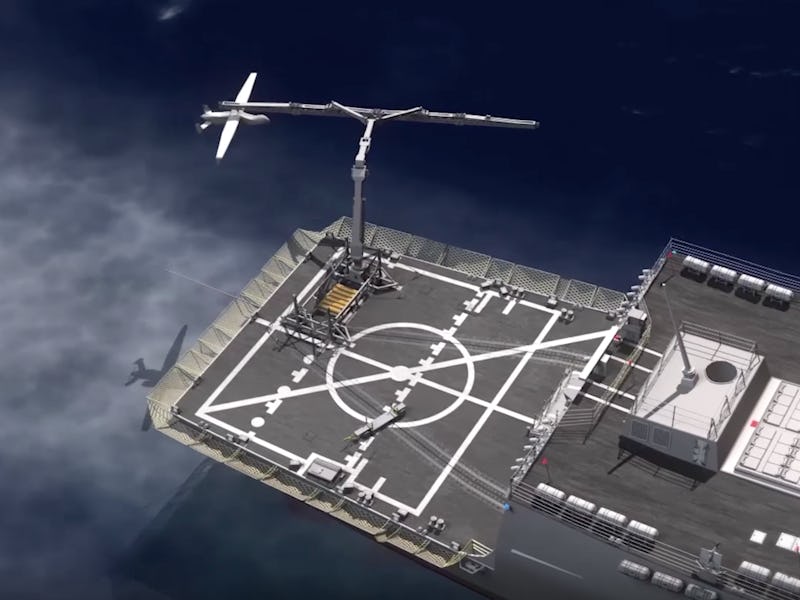DARPA is Developing a Drone Slingshot to Put on Aircraft Carriers
It's deceptively small, too.

One of the biggest modern problems for the United States military is not any lack of power to defeat a foe, but moving that firepower to where the foe actually operates.
In the current Syrian conflict, Turkey’s past refusal to allow U.S. aircraft to fly out of its most strategically useful bases forced the Americans to fly strike missions off aircraft carriers in the Persian Gulf. The time, fuel, and sheer difficulty of carrying out a campaign this way made American ambitions much harder to achieve in the region — but what if U.S. aircraft — specifically drones — could launch from a truck sitting just a few kilometers outside an enemy-held city?
That’s the sort of hypothetical that DARPA was created to address, and for several years the military’s advanced research arm has been funding research into how to make aircraft launch much more portable. Human-piloted aircraft are an immediate no-go — they’re necessarily heavy and complex, and you can’t accept even a tiny chance of failure when designing them and their systems. But drones are already simple, light, durable, and ultimately, expendable.
The DARPA drone-launcher project is called SideArm, and as the name suggests, it is focused on allowing a big mechanical arm to can both launch and catch meaningfully large drones, while costing and weighing far less than any preceding launch technology. It is also cool AF.
SideArm launches a drone off the side of an aircraft carrier in this DARPA concept video.
Past attempts at similar designs have used nets to simply catch drones, but this produces a rough landing that can damage heavier or more delicate technology. SideArm, by contrast, uses an attached hook on landing drones to hold onto a short rail track. This cushions the landing by providing space over which the drone can slow down. It might not seem like much, but by incorporating the rail, DARPA believes they can use SideArm to launch and retrieve drones weighing over 1,100 pounds.
This sped-up concept video shows how the SideArm catches a returning drone.
At least at first, the primary missions for SideArm drones will likely be surveillance — even empty, the U.S. military’s iconic Predator and Reaper drones weigh several times that limit. SideArm came out of the Tern project, which is aimed at developing new capabilities for Medium Altitude Long Endurance (MALE) drones just like the Predator, so it’s possible we’ll see later versions sacrifice some of SideArm’s portability for a higher maximum capacity. Strike drones could also perhaps afford to be lighter, if they had the drastically the reduced range requirements that SideArm could facilitate.
In general, small seems to be the order of the day for new drone development. It’s always good to be able to carry a missile, but the true potential of unmanned systems is in carrying out missions no human could ever hope to perform — and no human could ever hope to be a swarm of drones the size of small birds. Hand-launched surveillance drones are now a huge part of the military’s lineup — but at the end of the day, there’s always going to be a weight cost to pay with a high-altitude drone with a super-res cameras, or a medium-altitude drone with missiles.
In short, SideArm is less portable and more powerful than the human hand, but more portable and less powerful than a physical runway. It could one-day provide the U.S. military with the first truly intermediate drone launch solution, and since SideArm can fold up to fit into a regular shipping container for transport, that solution could let America’s pivot toward an autonomous military go further than ever before.